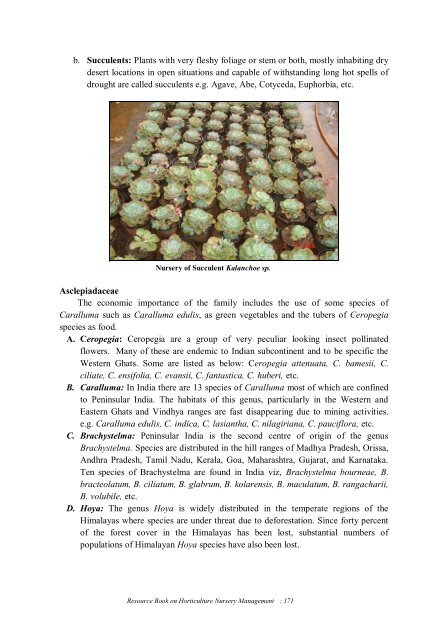Resource Book on Horticulture Nursery Management
Resource Book on Horticulture Nursery Management
Resource Book on Horticulture Nursery Management
Create successful ePaper yourself
Turn your PDF publications into a flip-book with our unique Google optimized e-Paper software.
. Succulents: Plants with very fleshy foliage or stem or both, mostly inhabiting dry<br />
desert locati<strong>on</strong>s in open situati<strong>on</strong>s and capable of withstanding l<strong>on</strong>g hot spells of<br />
drought are called succulents e.g. Agave, Abe, Cotyceda, Euphorbia, etc.<br />
<strong>Nursery</strong> of Succulent Kalanchoe sp.<br />
Asclepiadaceae<br />
The ec<strong>on</strong>omic importance of the family includes the use of some species of<br />
Caralluma such as Caralluma edulis, as green vegetables and the tubers of Ceropegia<br />
species as food.<br />
A. Ceropegia: Ceropegia are a group of very peculiar looking insect pollinated<br />
flowers. Many of these are endemic to Indian subc<strong>on</strong>tinent and to be specific the<br />
Western Ghats. Some are listed as below: Ceropegia attenuata, C. bamesii, C.<br />
ciliate, C. ensifolia, C. evansii, C. fantastica, C. huberi, etc.<br />
B. Caralluma: In India there are 13 species of Caralluma most of which are c<strong>on</strong>fined<br />
to Peninsular India. The habitats of this genus, particularly in the Western and<br />
Eastern Ghats and Vindhya ranges are fast disappearing due to mining activities.<br />
e.g. Caralluma edulis, C. indica, C. lasiantha, C. nilagiriana, C. pauciflora, etc.<br />
C. Brachystelma: Peninsular India is the sec<strong>on</strong>d centre of origin of the genus<br />
Brachystelma. Species are distributed in the hill ranges of Madhya Pradesh, Orissa,<br />
Andhra Pradesh, Tamil Nadu, Kerala, Goa, Maharashtra, Gujarat, and Karnataka.<br />
Ten species of Brachystelma are found in India viz, Brachystelma bourneae, B.<br />
bracteolatum, B. ciliatum, B. glabrum, B. kolarensis, B. maculatum, B. rangacharii,<br />
B. volubile, etc.<br />
D. Hoya: The genus Hoya is widely distributed in the temperate regi<strong>on</strong>s of the<br />
Himalayas where species are under threat due to deforestati<strong>on</strong>. Since forty percent<br />
of the forest cover in the Himalayas has been lost, substantial numbers of<br />
populati<strong>on</strong>s of Himalayan Hoya species have also been lost.<br />
<str<strong>on</strong>g>Resource</str<strong>on</strong>g> <str<strong>on</strong>g>Book</str<strong>on</strong>g> <strong>on</strong> <strong>Horticulture</strong> <strong>Nursery</strong> <strong>Management</strong> : 171











